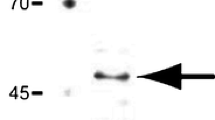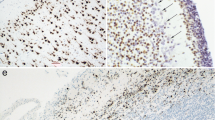Abstract
To elucidate the role of glycogen in the epithelium of developing digestive organs, we investigated the appearance of glycogen and glycogen phosphorylase (GP) in these organs. We studied 64 externally normal human embryos at Carnegie stages 13–23 (5.1–28.0 mm in crown-ramp length, 4–8 weeks of gestation) by histocytochemical staining for glycogen and immunohistochemical staining with antibodies against two isoenzymes of GP: brain-type (BGP) and mucle-brain-type (MBGP) GP. At stage 13, glycogen appeared in the epithelium of the digestive tract and the parenchyma of the pancreas. As development advanced, glycogen granules increased in number and size in these tissues, and they became evenly distributed in the epithelium of the digestive tract as either single particles or aggregates, as deduced by electron microscopy at late embryonic stages. Immunoreactivity specific both for BGP and for MBGP was detected in the digestive tract and the pancreas from stage 13. As development advanced, both BGP- and MBGP-immunoreactive cells increased in number and in immunoreactivity, and the number of MBGP-immunoreactive cells became larger than that of BGP-immunoreactive cells. By contrast, in hepatic cells, which serve as a major storage site for glycogen in adults, glycogen was detected only from stage 20, in smaller amounts, without formation of aggregates, and no immunoreactivity specific for BGP or MBGP was apparent throughout the embryonic stages examined. Thus, in the epithelium of the digestive tract and the parenchyma of the pancreas, but not in hepatic cells, the appearance and localization of GP coincided almost exactly with that of glycogen. These observations suggest that glycogen in the epithelium of the digestive tract and the parenchyma of the pancreas has not only been synthesized but also degraded from an early embryonic period and may, thus, be related to active cellular metabolism that is specific for embryonic development, including proliferation of the epithelium and interactions between epithelium and mesenchyme.
Similar content being viewed by others
References
Black BL (1988) Influence of hormones on glycogen and glucose metabolism in embryonic chick intestine. Am J Physiol 254:65–73
Bourne EJ, McLean A, Pridham JB (1966) The structure and deposition of human liver glycogens. Biochem J 98:678–681
Boyden EA, Cope JG, Bill AH (1967) Anatomy and embryology of congenital intrinsic obstruction of the duodenum. Am J Surg 114:190–202
Capková A, Jirásek JE (1968) Glycogen reserves in organs of human foetuses in the first half of pregnancy. Biol Neonat 13:129–143
Garbarsch C (1969) Histochemical studies on the early development of the human small intestine. Acta Anat 72:357–375
Graumann W (1964) Ergebnisse der PolysaccharidHistochemic: Mensch und Säugetiere. In: Graumann W, Neumann KH (eds) Handbuch der Histochemic II/2. Fischer, Stuttgart
Gumbiner BM (1992) Epithelial morphogenesis. Cell 69:385–387
Henion HF, Sutherland EW (1957) Immunological differences of phosphorylases. J Biol Chem 224:477–488
Hinrichsen K (ed) (1990) Humanembryologie. Strukturelle und funktionelle Differenzierung des Intestinaltraktes. Springer, Heidelberg Berlin New York, pp 551–570
Hotchkiss RD (1948) Microchemical reaction resulting in the staining of polysaccharide structures in fixed tissue preparations. Arch Biochem 16:131–141
Hsu SM, Raine L, Fanger H (1981) Use of avidin-biotin-peroxidase complex (ABC) in immunoperoxidase techniques: a comparison between ABC and unlabeled antibody (PAP) procedures. J Histochem Cytochem 29:577–580
Jirásek JE, Uher J, Koldovsky O (1965) A histochemical analysis of the development of the small intestine of human fetuses. Acta Histochem 22:33–39
Kato K, Shimizu A, Kurobe N, Muneshita M, Koshikawa T (1989) Human brain-type glycogen phosphorylase: quantitative localization in human tissues determined with an immunoassay system. J Neurochem 52:1425–1432
Lev R (1968) A histochemical study of glycogen and mucin in developing human foetal epithelia. Histochem J 1:152–165
Lev R, Weisberg H (1969) Human foetal epithelial glycogen: a histochemical and electron microscopic study. J Anat 105:337–349
Lev R, Siegel HI, Bartman J (1972) Histochemical studies of developing human fetal small intestine. Histochemie 29:103–119
Lillie RD (1949) Studies on histochemistry of normal and pathological mucins in man. Anat Rec 103:611–624
Lillie RD (1965) Carbohydrates. Histopathologic techniques and practical histochemistry, 3rd edn. Blakiston Division, McGraw-Hill, New York, pp 228–280
Liu HM, Potter EL (1962) Development of the human pancreas. Arch Pathol 74:439–452
Maxwell MH (1978) An on-grid method for the specific demonstration of glycogen in electron microscopy. Med Lab Sci 35:201–202
McKay DG, Admas EC, Hertig AT, Danziger S (1955) Histochemical horizons in human embryos. Anat Rec 122:125–151
McManus JF, Mowry RW (1963) Staining methods, Histologie and histochemical. Harper & Row, New York, pp 63–64
Moutsouris C (1966) The “solid stage” and congenital intestinal atresia. J Pediatr Surg 1:446–450
Newgard CB, Littman DR, Genderen C van, Smith M, Fletterick RJ (1988) Human brain glycogen phosphorylase: cloning, sequence analysis, chromosomal mapping, tissue expression, and comparison with the human liver and muscle isoenzymes. J Biol Chem 263:3850–3857
Nishimura H (1975) Prenatal versus postnatal malformations based on the Japanese experience on induced abortions in the human being. In: Blandau RJ (ed) Aging gametes. Karger, Basel, pp 349–368
Nishimura H (1983) Introduction. In: Nishimura H (ed) Atlas of human prenatal histology, 1st edn. Igaku-shoin, Tokyo, p 1
Nishimura H, Takano K, Tanimura T, Yasuda M (1968) Normal and abnormal development of human embryos: first report of the analysis of 1,213 intact embryos. Teratology 1:281–290
O'Rahilly R (1972) Guide to the staging of human embryos. Anat Anz 130:556–559
Otani H, Tanaka O (1988) Development of the choroid plexus analage and supra-ependymal structures in the fourth ventricular roof plate of human embryos: scanning electron microscopic observations. Am J Anat 181:53–56
Otani H, Tanaka O, Yoshioka T (1992) Supra-neuroectodermal cells and fibers on the primary nasal cavity and in the fourth ventricle of mouse and human embryos: scanning and transmission electron microscopic studies. Anat Rec 233:270–280
Otani H, Yoneyama T, Hashimoto R, Hatta T, Tanaka O (1993) Ultrastructure of the developing stomach in human embryos. Anat Embryol 187:145–151
Pearse AGE (1968) Histochemistry: theoretical and applied, 3rd edn. Little, Brown & Co, Boston, pp 330–354
Peyrot A (1957) Observazione sul comportamento del glicogeno nela morfogenesi della mucosa duodenale nel topo, nella cavia e nel pulcino. Monit Zoo Ital 64:107–120
Richter F, Böhme HJ, Hofmann E (1983) Developmental changes of glycogen phosphorylase b isozymes in rat tissues. Biomed Biochim Acta 42:1229–1235
Richter F, Böhme HJ, Hofmann E (1988) Changes of glycogen phosphorylase isozyme pattern, in rat tissues during pre- and postnatal development. Biomed Biochim Acta 47:743–752
Salenius P (1962) On the ontogenesis of the human gastric epithelial cells: a histologic and histochemical study. Acta Anat 50 [Suppl 46–1]:7–70
Sasse D (1968) Glykogen in der Ontogenese des Verdauungstrakts: chemomorphologische und stoffwechselhistochemische Analyse. Ergeb Anat 40:1–68
Sato K (1977) Carcinofetal alterations in isozymes with special reference to glycogen phosphorylase (in Japanese). Seikagaku 49:1091–1119
Sato K, Weinhouse S (1973) Purification and characterization of the Novikoff hepatoma glycogen phosphorylase and its relation to a fetal form. Arch Biochem Biophys 159:151–159
Sato K, Sato T, Morris HP, Weinhouse S (1975) Carcinofetal alterations in glycogen phosphorylase isoenzymes in rat hepatomas. Ann NY Acad Sci 259:273–286
Sato K, Satoh K, Sato T, Imai F, Morris HP (1976) Isozyme patterns of glycogen phosphorylase in rat tissues and transplantable hepatomas. Cancer Res 36:487–495
Schliselfeld LH, Davis CH, Krebs EG (1970) A comparison of phosphorylase isozymes in the rabbit. Biochemistry 9:4959–4965
Schmechel DE, Brightman MW, Marangos PJ (1980) Neurons switch from non-neuronal enolase to neuron-specific enolase during differentiation. Brain Res 190:195–214
Semba R, Tanaka O, Tanimura T (1983) Digestive system. In: Nishimura H (ed) Atlas of human prenatal histology, 1st edn. Igaku-shoin, Tokyo, pp 171–240
Shinohara H, Tanaka O (1988) Development of the notochord in human embryos: ultrastructural, histochemical, and immunohistochemical studies. Anat Rec 220:171–178
Tanaka O (1991) Variabilities in prenatal development of orofacial system. Anat Anz 172:97–107
Tanaka O, Koh T, Oki M (1979) Development of the esophagus in human embryos: special reference to histochemical study on carbohydrates. Shimane J Med Sci 3:77–90
Tanaka O, Otani H, Fujimoto K (1987) Fourth ventricular floor in human embryos: scanning electron microscopic observations. Am J Anat 178:193–203
Villee CA (1954) The intermediary metabolism of human fetal tissues. Cold Spring Harbor Symp Quant Biol 19:186–199
Wille KH (1988) Über die Zotteninvolution im fetalen Enddarm und das Vorkommen intraepithelialer Mekoniumkörperchen. Z Mikrosk Anat Forsch 102:150–164
Author information
Authors and Affiliations
Rights and permissions
About this article
Cite this article
Hashimoto, K., Tamura, K., Otani, H. et al. Histocytochemical and immunohistochemical studies related to the role of glycogen in human developing digestive organs. Anat Embryol 192, 497–505 (1995). https://doi.org/10.1007/BF00187180
Accepted:
Issue Date:
DOI: https://doi.org/10.1007/BF00187180




